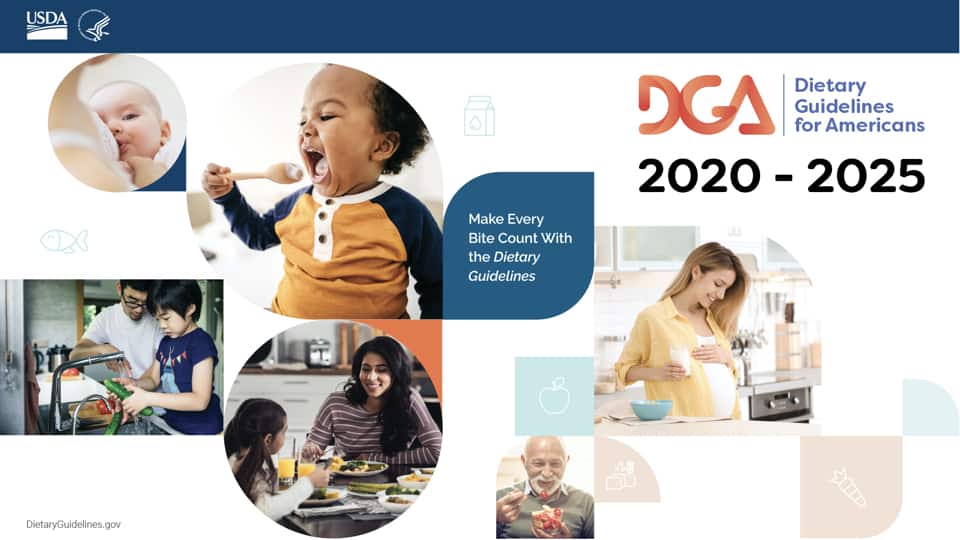Wow, five years have flown by and the new version of the Dietary Guidelines for Americans have just been released. The release of updated Dietary Guidelines happens every 5 years. This allows improved scientific findings to be folded into the USDA’s healthy eating recommendations. It is an important event for nutrition professionals, public policy makers, and organizations which use them as standards for delivery of food, products, and nutrition services. At Guiding Stars, we translate the latest science and regulations to make it easier to find nourishing foods. We closely examine updates to these guidelines. We adjust our algorithms to make sure our star ratings provide the most accurate, up-to-date, at-a-glance healthy eating guidance.
The last time I wrote about the Dietary Guidelines (for the 2015 version), I explained how the guidelines are used, and how they are changed.
What are the 2020-2025 Dietary Guidelines?

The Dietary Guidelines are overall recommendations, not a giant list telling you to “eat this” and “don’t eat that.” They aim to help people develop eating patterns that focus on food and drink choices that support a lifetime of good health. They don’t provide specific food requirements. This time, they remind us to consume nutrient-dense foods over our lifetimes to help us optimize our health and avoid chronic disease. This time around, there are simply four guidelines:
- Follow a healthy dietary pattern at every life stage.
- Customize and enjoy nutrient-dense food and beverage choices to reflect personal preferences, cultural traditions and budgetary considerations.
- Focus on meeting food group needs with nutrient-dense foods and beverages, and stay within calorie limits.
- Limit foods and beverages higher in added sugars, saturated fat, and sodium, and limit alcoholic beverages.
How have the guidelines changed?
Recommendations for eating by life stage
These guidelines, for the first time, provide advice for dietary habits by “life stages.” This maps recommendations to pregnancy/lactation, infancy through toddler-hood, children and adolescence, adulthood, and older adulthood. An example of a specific “life-stage” change is a call for infants and toddlers to avoid added sugars entirely. Now, for ages 2+, the recommendation is to limit added sugars to less then 10% of calories per day.
Specific advice for pregnant and lactating individuals
For the first time, the guidelines now include specific advice for pregnant and lactating individuals. They offer estimations of how one should estimate calories over pregnancy stages. Additionally, there are nutrient suggestions, like a recommendation to eat 8-12 ounces of lower-mercury level seafood per week.
Instructions for early introduction of potentially allergenic foods
A major recommendation added is to introduce infants and young children to potentially allergenic foods around 6 months and before a year. Of course, you should clear it with your pediatrician first for your specific situation.
More emphasis to cultural foodways, diversity, and eating within a budget
This set of guidelines tries to create a framework which recommends groups of foods, rather then specific foods and beverages. The hope is this approach will allow people to make their own healthy choices within the foods and beverages available to them.
Making the Dietary Guidelines work for you
The guidelines represent the current thinking on the intersection of food, health, and chronic disease. Condensing all of that down into one document is a big job—and the document itself is big, too. In general, the Dietary Guidelines are for professionals, government/policy makers and the food industry. Consumers can certainly learn a lot by reading every page of it (all 149 pages), but there is a great resource for consumers that might be easier to swallow!
Scoot over to the newly revised MyPlate website. The MyPlate program is the consumer-facing version of the Dietary Guidelines, and has been refreshed with the release of updated advice. The focus is on personalized food choices, starting simple, and making every bite count (in terms of nutrition content). There are tools, infographics, resources, recipes, food lists, and videos to support your understanding. There’s even an app that includes goal-setting tools and challenges.
Here at Guiding Stars, we try to distill the scientific advice of how to eat healthier into a rating which helps you quickly snag healthier choices whether you shop in-store or online. So while you check out the updated guidelines and MyPlate tools, I’ll be meeting with the other members of the Guiding Stars Scientific Advisory Panel to determine what adjustments we will make to the criteria we use to evaluate foods.